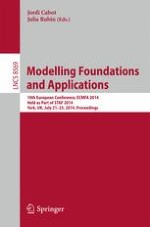2014 | Book
Modelling Foundations and Applications
10th European Conference, ECMFA 2014, Held as Part of STAF 2014, York, UK, July 21-25, 2014. Proceedings
Editors: Jordi Cabot, Julia Rubin
Publisher: Springer International Publishing
Book Series : Lecture Notes in Computer Science
